This blog post will cover the importance of regional alliances in energy markets and the core reason driving the recent creation of the Southeast Energy Exchange Market (SEEM).
Introduction
People support what they help to create.
What does that statement have to do with solving complex energy market challenges?
Everything.
We often get too consumed with the “how” we do things in today’s world and forget about the “why” we initially choose to do them.
We also tremendously discount the power of relationships.
Regional challenges require regional solutions created by authentic consensus from a group of stakeholders facing a common challenge.
Southwest Power Pool Story
Many years ago, I was fortunate to be exposed to the creation of SPP’s imbalance market and eventual Integrated Marketplace.
I don’t remember the hundreds of hours of debates about “how” these markets should and would operate from that time in my career.
However, I do recall the fantastic job of SPP leadership to explain “why” the organization began in the first place.
It is a story worth repeating here.
The United States was attacked at Pearl Harbor on December 7th, 1941. The nation was nowhere near ready to fight a world war, and the immediate need was clear.
We needed to create steel and aluminum to build boats and planes.
Lots of them.

SPP began in 1941 when 11 regional power firms pooled their resources to keep Arkansas’ Jones Mill running 24 hours a day, seven days a week, to fulfill crucial national defense needs.
SPP’s Executive Committee chose to keep the organization after the war to ensure energy reliability and coordination.
As the folks in the SPP Little Rock headquarters like to say, “Eight decades later, SPP still reflects our early principles of collaboration in the interest of providing a critical service for the good of our region. Our vision is to lead our industry to a brighter future, delivering the best energy value.”
The trust of time-tested relationships forged in the survival of our nation allowed SPP to integrate more wind than anywhere else in the past twenty years and the transmission build-out to go with the expansion.
Has it been perfect? No.
Has it been effective? Extremely
Southeast Exchange Energy Market (SEEM)
The Clean Power Plan was a strategy announced by the Environmental Protection Agency (EPA) in June 2014 as part of the Obama administration’s efforts to counteract climate change.
Each state was given a specific objective for lowering carbon emissions, which they may achieve in any way they saw fit, but the EPA might intervene if they failed to submit a plan.
Not surprisingly, each state and each region took different approaches toward meeting the plan’s requirements.
The Southeast decided to build nuclear power plants, wind farms, and a tremendous amount of utility-scale solar power.
When you consider the amazing population growth of the southeast during the past twenty years and the changing load profiles, you can begin to consider “why” a group of energy companies decided to meet and discuss how to integrate renewable energy best, maintain grid reliability, and keep power affordable for the region.
The integration of solar power in the Southeast poses unique regional reliability challenges associated with operating the power grid.
Without getting into the science and electrical engineering details in this post, let’s say the heat and humidity cause uncertain summer storms and often increase the intermittency of solar generation due to hard-to-predict cloud formations.
While technology is helping to address these challenges today and tomorrow, the bottom line is that maintaining grid frequency at 60 hertz (Hz) as reasonably as possible can be extremely challenging at times.
Balancing load and generation in the Southeast have some unique characteristics and challenges to other regions of the United States.
In the Southeast, wind and solar resources are quickly developing.
What is the core reason for the creation of SEEM?
It is reliable integration of a rapidly growing fleet of renewable generation.
Different Strokes For Different Folks
In 2007, I moved my family to the Pacific Northwest to assume a leadership position with my energy company.
I think it took me about one month of meetings to quickly realize that I was now living and working in a region that thought about energy issues entirely differently than my previous experiences.
What did I hear most often?
“Regional challenges require regional solutions.” “We do not want a costly bureaucratic organization with a top-down approach infringing upon our ability to gain consensus with our neighbors.”
Sound familiar?
Earlier this year, Tony Clark and Vince Duane published a white paper, Stretched to the Breaking Point-RTOs And The Clean Energy Transition. They challenged what they called “the prevailing orthodoxy … that the road to the decarbonized, advanced technology grid of the future goes through a Regional Transmission Organization.”
Last July, Tony Clark co-authored an article, It’s time for emergent markets to take center stage in non-RTO regions of the country.
According to Clark, the emergent markets bring three qualities any market needs:
- Simplicity
- Adaptability
- Stability
The projected Southeast Energy Exchange Market (SEEM) in the Southeast United States fits neatly with the Western Energy Imbalance Market’s (EIM) progressive evolution. Both represent the efforts of local stakeholders who see benefits for customers, utilities, and the region with an evolutionary, adaptive model that enhances the ability to buy and sell power.
Conclusion
The only Latin words that I have remembered from the many attempts by teachers throughout my educational career were those engraved on my Chaminade High School class ring.
Fortes in Unitate.
Strength in Unity.
If you never lose focus on “why” your organization exists, especially a joint action type of business model, the “how” you achieve your objectives becomes easier because you have strength in unity.
That strength allows necessary spirited discourse and debate on the “how” and considers the viewpoints of many stakeholders.
Organizations that lose the focus on “why” your organization exists permanently lose their luster and eventually wither on the vine.
It’s a key reason why companies should continue to focus on retaining their veteran staff because they can be a critical bridge to ensuring the core history of the organization is never forgotten.
The SEEM market exists because a regional group of entities faces a common challenge to cost-effectively and reliably integrate a rapidly growing renewable energy.
Emerging markets should be embraced as a reasonable, realistic choice for specific locations, and policymakers should embrace them as a promising new model for the future of the U.S. grid.
Regional challenges require regional solutions.







